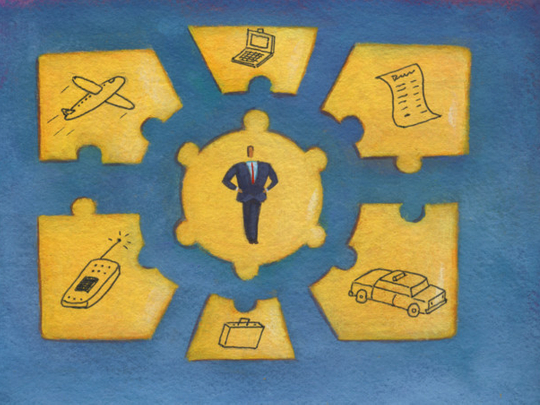
Imagine this scene at the airport — you get off the plane, pull your luggage off the conveyor belt and simply start walking, your bags following you in a neat line while everyone around gapes. No, this is not a fantasy — the technology actually exists. Called The Hop, it uses embedded sensors that connect to your smartphone for guidance.
And how about the Beam Brush, the world’s first smart toothbrush? It monitors your brushing habits and sends data to your phone. It even lets you set brushing goals and expects you to smile as you achieve them.
If you step out for a workout, you could try Nike’s Hyperdunk+ or LunarTR1+ shoes. Multiple embedded sensors measure your moves, jumps and agility and wirelessly sync to a mobile app. At work, you could be wearing a Casio smart watch that automatically locks the computer as you walk away from your seat, and unlocks it when you return.
Powering these and other smart ideas is the latest iteration of Bluetooth technology — version 4.0 or Bluetooth Smart or Low Energy (BLE).
Most users associate Bluetooth with power drain and tanking battery levels. But BLE comes in at the other extreme — it is frugal par excellence. It works by sending data in short bursts using bare minimum power. Peak usage currents are in the tens of milliamps (mA), while in sleep mode that plummets to tens of nanoamps (nA). The bottom line is that you can run BLE on cheap button cells instead of expensive and bulky rechargeables. In fact, Casio claims its smart watch will go two years before a battery change.
This makes BLE ideal for use in all kinds of sensors and monitors. A 2010 report from research firm Gartner says BLE will enable a range of new sensor-based business models in industries such as fitness, health care and environmental control, and will be used by handset and PC peripherals to enable new functions.
BLE is also shaking up the market for expensive dedicated devices. Since sensors can talk directly to smartphones, all you need is an app that picks up the data and displays it whichever way you want, including cute pie charts and bar graphs. The end result? Innovative gadgets for cheap. Lisa Arrowsmith, Senior Analyst with IMS Research, an electronics market research firm, notes, “Fortunately for the sports and fitness industry there is the opportunity to provide accessories such as pedometers or heart rate sensors to enhance the functionality of sports and fitness apps, and provide further revenue generation to counter any potential reduction through declining interest in stand-alone monitors.”
Businesses have most definitely woken up to this potential. Nike’s new FuelBand fitness monitor uses BLE, while competitor Fitbit’s tracker does away with the ungainly desktop dock and talks directly to your phone. BodyMedia, Wahoo, Runtastic, Scosche and others have rolled out BLE heart rate monitors, Ace Sensor offers a smart key finder and weighing scales, and Motorola a fitness watch. Buffalo and Logitech have got proximity tags out, Lumoback showcased a smart posture sensor, and Ten One Design showcased the Pogo Connect Stylus. Then there are anti-loss devices, glucose monitors, stethoscopes, pulse oximeters, cycling monitors, headsets, keyboards, mice and speakers.
The competition
BLE is certainly going where no Bluetooth device has gone before. Mark Powell, Executive Director of Bluetooth Special Interest Group (SIG), which oversees the development of standards and licensing, says, “Even at more than seven billion Bluetooth units shipped to date, we’ve just scratched the surface.”
BLE is currently duking it out with other short-range technologies such as Near Field Communication (NFC) and ANT+. NFC has some heavy-duty backers, among them Google, and is making steady inroads into the mobile payment space. ANT+ has been around longer and is already used in fitness gear by companies such as Adidas and Garmin, while HTC’s One X and smartphones by Sony come with ANT+ baked in.
But the game changer has been Apple. It sent a clear message when it joined the executive board of Bluetooth SIG. With its massive reach in the smartphones and tablets space, Apple has been the biggest ambassador for Bluetooth. Its new iPad is the first tablet with BLE. The iPhone 4S, iPhone 5, the new Macbooks, Mac Minis and iPods — all have it. As technology writer Matthew Humphries points out on geek.com, “The question is, will retailers respond by embracing Bluetooth (over NFC) as a payment option? Millions of iPhone 5 sales mean they more than likely will.”
The other big player, Samsung, seems to be sitting on the fence. Its top-end phones, such as the Galaxy SIII and Note II, include NFC and Bluetooth 4.0. It’s a similar case with Nokia’s latest Windows 8 Lumia phones.
Microsoft has given BLE a huge thumbs up by natively adding it to the Windows 8 OS and Surface tablets. Suke Jawanda, Bluetooth SIG Chief Marketing Officer, says, “With Bluetooth v4.0 incorporated into the Windows operating system, hardware and software developers will have increased opportunities to provide new devices, applications and services for their customers.”
Winning the battle
It looks like Bluetooth will steamroll the competition. The technology has been around for 18 years and the industry body has around 17,000 members. According to Bluetooth SIG, over five million Bluetooth-enabled devices are commercialised every single day, and ABI Research, a firm specialising in global technology markets, expects 20 billion cumulative Bluetooth-enabled device shipments by 2017.
IMS Research predicts that by next year, a billion BLE devices will be sold every year — “by far the fastest adoption rate of any wireless technology”. And in four years, BLE will even dominate the health-care market — “more than 4.7 million consumer medical devices containing BLE technology will be shipped in 2016.” Arrowsmith adds, “By 2015, all phones enabled with Bluetooth will be BLE ready.”










